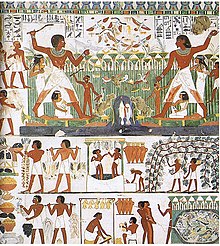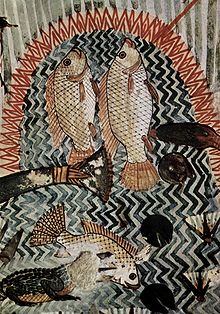
Aegean civilization is a general term for the Bronze Age civilizations of Greece around the Aegean Sea. There are three distinct but communicating and interacting geographic regions covered by this term: Crete, the Cyclades and the Greek mainland. Crete is associated with the Minoan civilization from the Early Bronze Age. The Cycladic civilization converges with the mainland during the Early Helladic ("Minyan") period and with Crete in the Middle Minoan period. From c. 1450 BC, the Greek Mycenaean civilization spreads to Crete, probably by military conquest. The earlier Aegean farming populations of Neolithic Greece brought agriculture westward into Europe before 5,000 BC.
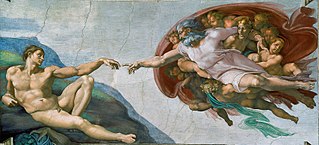
Fresco is a technique of mural painting executed upon freshly laid ("wet") lime plaster. Water is used as the vehicle for the dry-powder pigment to merge with the plaster, and with the setting of the plaster, the painting becomes an integral part of the wall. The word fresco is derived from the Italian adjective fresco meaning "fresh", and may thus be contrasted with fresco-secco or secco mural painting techniques, which are applied to dried plaster, to supplement painting in fresco. The fresco technique has been employed since antiquity and is closely associated with Italian Renaissance painting.

The Minoan civilization was a Bronze Age culture which was centered on the island of Crete. Known for its monumental architecture and energetic art, it is often regarded as the first civilization in Europe. The ruins of the Minoan palaces at Knossos and Phaistos are popular tourist attractions.
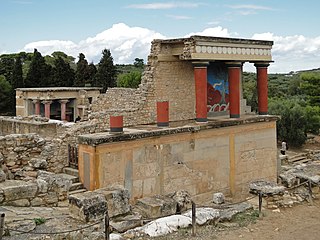
Knossos is a Bronze Age archaeological site in Crete. The site was a major center of the Minoan civilization and is known for its association with the Greek myth of Theseus and the minotaur. It is located on the outskirts of Heraklion, and remains a popular tourist destination.

Ancient art refers to the many types of art produced by the advanced cultures of ancient societies with different forms of writing, such as those of ancient China, India, Mesopotamia, Persia, Palestine, Egypt, Greece, and Rome. The art of pre-literate societies is normally referred to as prehistoric art and is not covered here. Although some pre-Columbian cultures developed writing during the centuries before the arrival of Europeans, on grounds of dating these are covered at pre-Columbian art and articles such as Maya art, Aztec art, and Olmec art.

Ancient Egyptian art refers to art produced in ancient Egypt between the 6th millennium BC and the 4th century AD, spanning from Prehistoric Egypt until the Christianization of Roman Egypt. It includes paintings, sculptures, drawings on papyrus, faience, jewelry, ivories, architecture, and other art media. It was a conservative tradition whose style changed very little over time. Much of the surviving examples comes from tombs and monuments, giving insight into the ancient Egyptian afterlife beliefs.
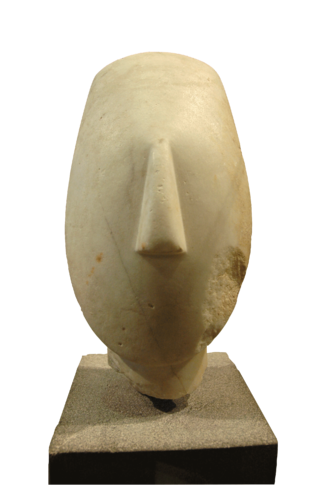
Aegean art is art that was created in the lands surrounding, and the islands within, the Aegean Sea during the Bronze Age, that is, until the 11th century BC, before Ancient Greek art. Because is it mostly found in the territory of modern Greece, it is sometimes called Greek Bronze Age art, though it includes not just the art of the Mycenaean Greeks, but also that of the Cycladic and Minoan cultures, which converged over time.

Minoan pottery has been used as a tool for dating the mute Minoan civilization. Its restless sequence of quirky maturing artistic styles reveals something of Minoan patrons' pleasure in novelty while they assist archaeologists in assigning relative dates to the strata of their sites. Pots that contained oils and ointments, exported from 18th century BC Crete, have been found at sites through the Aegean islands and mainland Greece, in Cyprus, along coastal Syria and in Egypt, showing the wide trading contacts of the Minoans.

Minoan religion was the religion of the Bronze Age Minoan civilization of Crete. In the absence of readable texts from most of the period, modern scholars have reconstructed it almost totally on the basis of archaeological evidence of such as Minoan paintings, statuettes, vessels for rituals and seals and rings. Minoan religion is considered to have been closely related to Near Eastern ancient religions, and its central deity is generally agreed to have been a goddess, although a number of deities are now generally thought to have been worshipped. Prominent Minoan sacred symbols include the bull and the horns of consecration, the labrys double-headed axe, and possibly the serpent.

Akrotiri is the site of a Cycladic Bronze Age settlement on the volcanic Greek island of Santorini (Thera). The name comes from the nearby village of Akrotiri.

Minoan art is the art produced by the Bronze Age Aegean Minoan civilization from about 3000 to 1100 BC, though the most extensive and finest survivals come from approximately 2300 to 1400 BC. It forms part of the wider grouping of Aegean art, and in later periods came for a time to have a dominant influence over Cycladic art. Since wood and textiles have decomposed, the best-preserved surviving examples of Minoan art are its pottery, palace architecture, small sculptures in various materials, jewellery, metal vessels, and intricately-carved seals.

Tell el-Dab'a is an archaeological site in the Nile Delta region of Egypt where Avaris, the capital city of the Hyksos, once stood. Avaris was occupied by Asiatics from the end of the 12th through the 13th Dynasty. The site is known primarily for its Minoan frescoes.

Nefermaat I was an ancient Egyptian prince, a son of king Sneferu. He was a vizier possessing the titles of the king's eldest son, royal seal bearer, and prophet of Bastet. His name means "Maat is beautiful" or "With perfect justice".
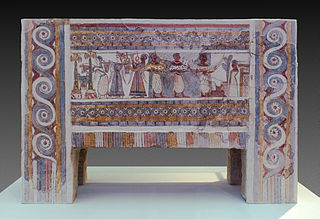
The Hagia Triada Sarcophagus is a late Minoan 137 cm (54 in)-long limestone sarcophagus, dated to around 1400 BC or some decades later, excavated from a chamber tomb at Hagia Triada, Crete in 1903 and now on display at the Heraklion Archaeological Museum (AMH) in Crete, Greece.

Minoan seals are impression seals in the form of carved gemstones and similar pieces in metal, ivory and other materials produced in the Minoan civilization. They are an important part of Minoan art, and have been found in quantity at specific sites, for example in Knossos, Mallia and Phaistos. They were evidently used as a means of identifying documents and objects.
The Minoan wall paintings at Tell el-Dab'a are of particular interest to Egyptologists and archaeologists. They are of Minoan style, content, and technology, but there is uncertainty over the ethnic identity of the artists. The paintings depict images of bull-leaping, bull-grappling, griffins, and hunts. They were discovered by a team of archaeologists led by Manfred Bietak, in the palace district of the Thutmosid period at Tell el-Dab'a. The frescoes date to the Eighteenth dynasty of Egypt, most likely during the reigns of either the pharaohs Hatshepsut or Thutmose III, after being previously considered to belong to the late Second Intermediate Period. The paintings indicate an involvement of Egypt in international relations and cultural exchanges with the Eastern Mediterranean either through marriage or exchange of gifts.

The wall paintings of ancient Thera are famous frescoes discovered by Spyridon Marinatos at the excavations of Akrotiri on the Greek island of Santorini. They are regarded as part of Minoan art, although the culture of Thera was somewhat different from that of Crete, and the political relationship between the two islands at the time is unclear. They have the advantage of mostly being excavated in a more complete condition, still on their walls, than Minoan paintings from Knossos and other Cretan sites.

The Monterozzi necropolis is an Etruscan necropolis on a hill east of Tarquinia in Lazio, Italy. The necropolis has about 6,000 graves, the oldest of which dates to the 7th century BC. About 200 of the tomb chambers are decorated with frescos.

The Akrotiri Boxer Fresco, discovered in 1967, is one of the Wall Paintings of Thera and a leading example of Minoan painting. It is a fresco depicting two young boys wearing boxing gloves and belts and dates back to the Bronze Age, 1700 BCE. Around 1600 BCE, a disastrous earthquake, followed by a volcanic eruption, covered Akrotiri, Greece in a thick layer of pumice and ash, which resulted in the remarkable conservation of frescoes, including the Akrotiri Boxer Fresco, from multiple buildings throughout the town. This particular fresco was found in room B1 of Building Beta along with the Antelope Fresco. The boys' shaved heads and stray locks indicate their youth, while their darker skin tone indicates their gender. The boy on the right is completely nude except for a belt, whereas the boy on the left has jewellery; most likely markers of a higher status. They appear to be slightly over life-size at roughly 5 ft 10 in (1.78 m). To create such vibrant frescoes, a smooth lime plaster was applied to the walls and then painted over. It is impossible to know whether the match was a competitive one or simply a routine sport.
